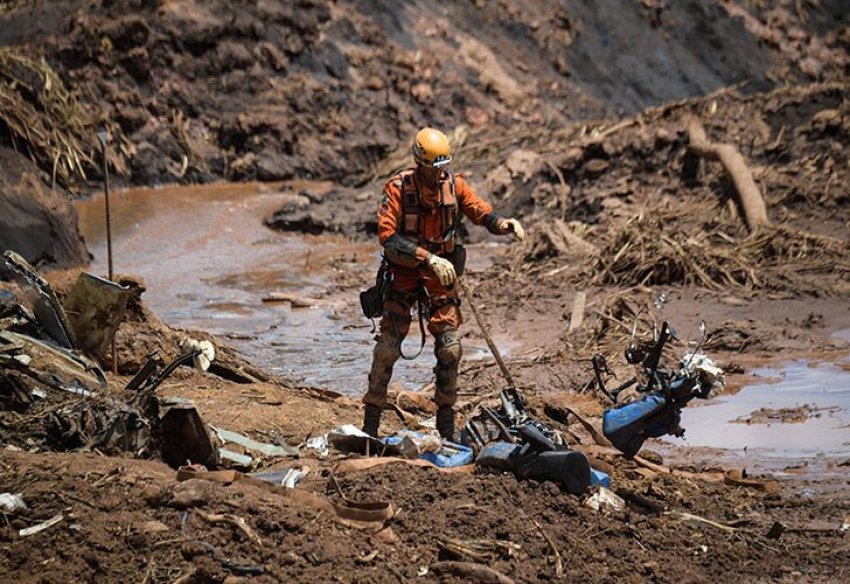
The world’s second biggest producer of iron ore, Vale, has again distanced itself from an ecological and workplace disaster of its own making, writes Pip Hinman.
On January 25, its Córrego do Feijão tailings dam in Brumadinho in the Brazilian state of Minas Gerais burst, releasing a tsunami of red mud and waste.
Vale claims it is not responsible for this second disaster in three years, but few believe it.
“They all knew the dam could break,” a distraught Daniela Fernandes de Oliveira told the January 29 Financial Times. Her husband was inside a restaurant that was swept away.
“The same thing that happened with Mariana happened again. Are they never going to learn? Mariana was the first one, Brumadinho the second. Will there be a third? A fourth? It’s unbelievable.”
Mariana, also in Minas Gerais, is the site of another of Vale’s tailings dam disasters. In November 2015, 50 million cubic metres of tailings slurry from its Samarco mine — enough to fill 20,000 Olympic-sized swimming pools — poured down the mountain, spreading across 800 kilometres.
That mine is jointly owned by Vale and Australian corporate giant BHP. At the time, both blamed small seismic tremors, but geologists rejected that explanation. An independent report from 2013 showed that Vale had been warned about its tailings dams’ lack of structural integrity.
Nineteen people died in the 2015 disaster. This time the numbers are higher: 58 have been declared dead, but that number is likely to rise as hope fades for 413 people — Vale employees and subcontractors — still missing.
The scale of such disasters is hard to comprehend. The London Mining Network said that the Vale-BHP dam break in 2015 devastated communities all along the Rio Doce river system: 1.4 million people needed urgent help to remediate ecosystems and restore livelihoods. They are still waiting to be compensated.
Last November, a number of affected people launched a class action against BHP-Billiton for US$7 billion. They point out that BHP had undertaken a worst-case assessment investigation six months before the Samarco tailings dam collapse and its findings included that a “liquification break” could mean up to 20 deaths, cause serious impacts to land, water resources and biodiversity over 20 years and cost up to US$3.4 billion.
Vale and BHP refuse to take responsibility, saying that safety had been and remained a priority.
Community organisations have hit back at the company and the state government for ignoring their warnings about the Córrego do Feijão dam.
In December, the National Civil Society Forum on the Management of Hydrographic Basins called on the state secretary of the environment to suspend Vale’s license. In January, it said: “Those responsible for these crimes cannot claim ignorance.”
Brazil’s National Mining Agency had sanguinely categorised it as “low risk” for accidents but “high potential” to cause damage if accidents were to occur.
But the Brazilian-based Movement of People Affected by Dams said there had been numerous complaints about the risk of the Córrego do Feijão mine dam breaking, yet the State Council for Environmental Policy approved its massive expansion last December.
On January 28, CIDSE (International Cooperation for Development and Solidarity) said the people of Brumadinho and the region had been demonstrating against the Córrego do Feijão mine since 2011.
Payal Sampat, the mining director of the US organisation Earthwork, said Vale’s latest dam failure is “all the more tragic because the mining industry knows how to prevent them, yet failed to act”.
Sampat said that best practice engineering for tailings’ storage — which came about after a copper and gold mine tailings dam bust at the Mt Prolley mine in British Colombia in Canada in 2014 — had been ignored by Vale. Independent research into mine waste dam failures since the turn of the 20th century shows that these catastrophic failures are taking place more frequently.
Rodrigo Peret, spokesperson from the Brazilian-based Churches and Mining Network who went to the spill area, condemned Vale and the state government for criminal impunity.
“Different civil society organisations warned that this could happen, and it did,” Peret said. “Three years after Mariana, this new crime … is evidence of the way the authorities and mining companies systematically ignore the constant denunciations made by community, civil society organisations and social movements.
“Vale remains unpunished, with irresponsible and illegal conduct covered up by authorities. This new disaster shows that mining is based on a development model which is unsustainable and lethal.”